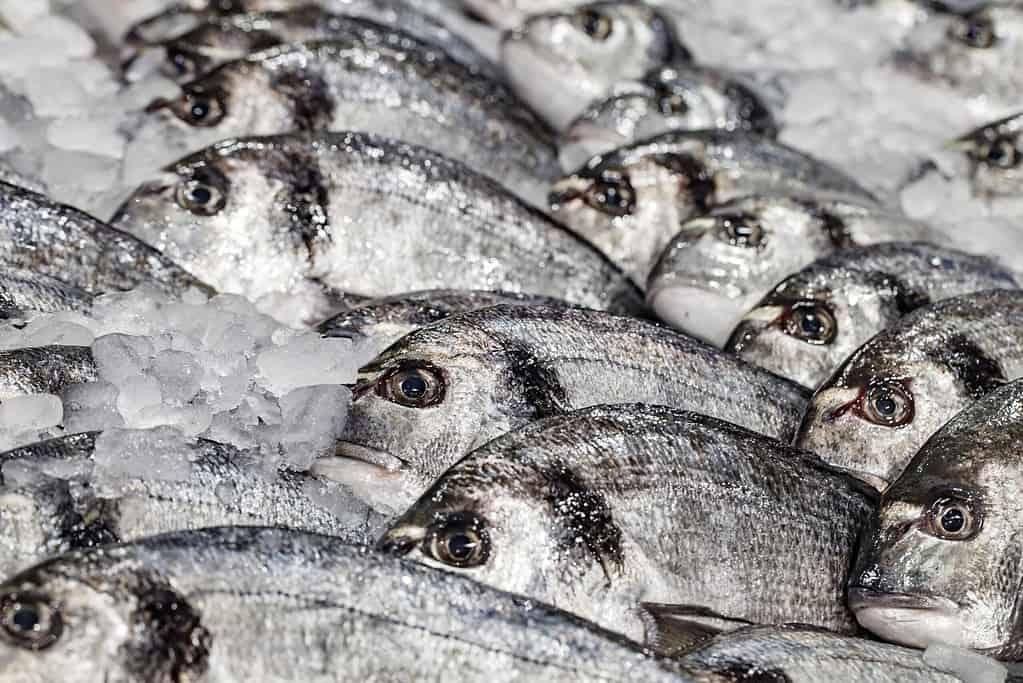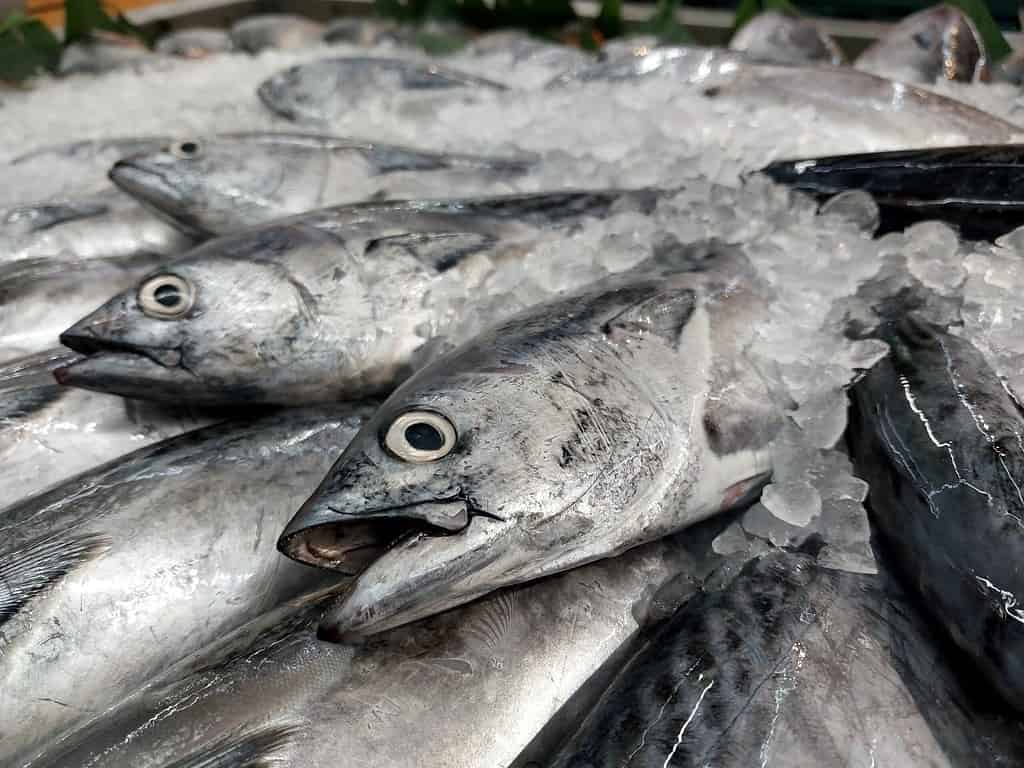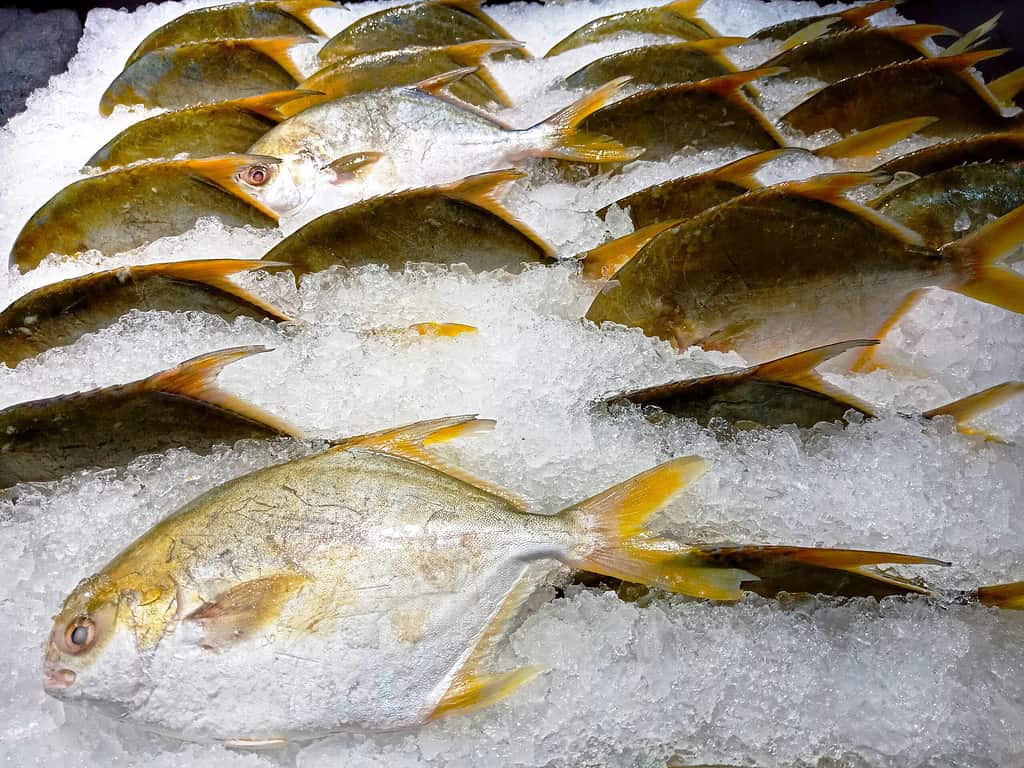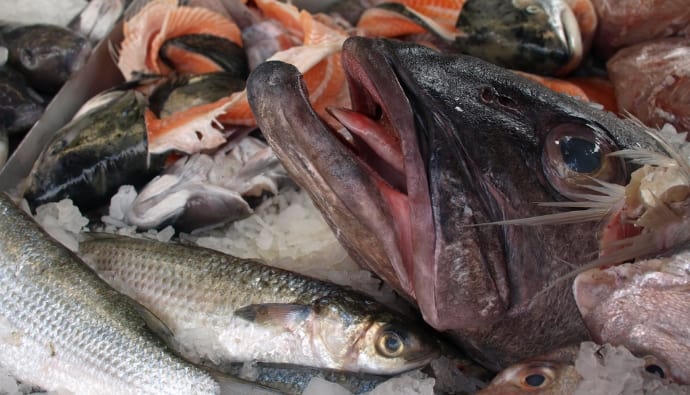Are you wondering if the fish you left in your cooler overnight is still safe to eat? I used to think fresh fish was always best, but after talking with chefs, fishmongers, and die-hard fishermen, I changed my perspective on fish storage. This guide examines how long you can store fish before it goes bad.
The Short Answer
Fish can be kept on ice for up to two days if you don’t gut them. They can stay good for up to five days if bled and gutted before putting them on ice. Fishmongers and chefs recommend using the ikejime method, bleeding the fish, and using crushed ice to coat the fish in a cooler with a drainage spout. Cooling the fish in a saltwater ice bath works best for total fish coverage.

What Makes Fish Fresh
Picture a fish swimming happily in the water. If we could ask it, “What makes you fresh, Mr. Fish?” it would probably say three things – texture, smell, and color.
- First, the texture. A fish in good condition is like a water ballet dancer; its body is firm, and its skin springs back when you touch it. On the other hand, not-so-fresh ones feel soft and leave an indentation when you press their skin.
- Second, the smell. A fish doesn’t smell fishy. No kidding! It has a light, clean smell, almost like the salty sea breeze at the beach. If a fish smells strong or unpleasant, it’s telling you, “I’m not fresh anymore!”
- And last, the color. Fish should have clear, bright eyes, almost like they’re telling you a story. Their gills are red, and their skin has a shiny and metallic glow. If their eyes look cloudy, their gills aren’t red, or their skin is dull, they’re not at their freshest.
Why Ice Is Used for Preserving Fish

Now, let’s call in our sidekick, ice! Ice is used to preserve fish because it has a superpower of its own: it can slow down the clock. Well, the clock of decomposition, at least.
You see, fish start to break down as soon as they leave the water, thanks to bacteria and enzymes. But bacteria and enzymes are like villains who hate the cold. So, when you freeze, and you put fish on ice, it’s like sending these villains into a winter sleep. They slow down, and the fish stays fresh for longer.
With this in mind, you can keep a fish alive or chill it with ice from the time you catch it until it’s stored. This keeps your frozen fish in good condition until it’s ready to be cooked.
Just like a superhero uses a shield to protect against villains, using ice to store fish is like giving fish a shield against decomposition. It helps maintain the texture, smell, and color, allowing us to enjoy its goodness for as long as possible. So, remember, when it comes to preserving fish, ice is your trusty sidekick!
How Long Can You Keep Fish on Ice

It depends on the temperature and conditions, but a fish can stay super for about five days with proper icing.
Just remember, this is the magic number under ideal conditions. But don’t worry; we will uncover what those ideal conditions are next!
Factors Influencing Freshness Duration
- Type of fish: Some fish are like the strongest superheroes – they can stay fresh for longer. Fatty fish like salmon can stay fresh on ice for up to 2 days, while lean fish like bass can last up to 5 days.
- Quality of ice: Not all ice is created equal! The colder your ice, the better. Crushed ice is usually best as it surrounds the fish better than block ice.
- Packing method: How you pack your fish on ice makes a big difference. You want to surround your fish with ice, not just on the top or bottom. Think of it like a fish-ice sandwich!
Signs of Fish Going Bad
Now, just as every superhero can spot trouble, we must recognize when our frozen fish has gone from fantastic to foul. Even when stored on ice, a fish will eventually go bad. Here’s what to watch for:
- Smell: Remember, a fresh fish should smell clean and mildly salty, just like the sea. If your fish starts to smell strong or unpleasant, it’s a clear sign it’s no longer fresh.
- Texture: Feel your fish. If it’s slimy or mushy, it’s time to say goodbye. Fresh fish should feel firm and bounce back when you touch it.
- Color: Look at your fish. If it’s losing its color or turning dark, it’s likely past its prime.
Just like a true superhero, being vigilant and using your senses will help you make sure your fresh caught fish always stays in the freshest state possible while on ice.
Preparing Fish for Icing
Before placing the fish on the ice, it needs preparation.
- Clean your fish: Rinse the fish with clean water. This helps remove dirt or scales that might speed up the breakdown process.
- Gut your fish: If possible, remove the insides of the fish. This might sound a bit icky, but it helps keep the fish fresh for longer. Don’t forget to give it another rinse afterward!
Correct Icing Technique
Here’s your step-by-step guide
- Chill the Base: Kick things off by creating an icy foundation. Spread a generous layer of ice on the bottom of your fishing cooler. It’s the first step in making a cool bed for your fish.
- Introduce the Star: Next, it’s time to nestle your fish onto this icy throne. Lay them gently, ensuring they have enough room to chill out. Avoid squashing them together – after all, no one likes to be the sardine in a can.
- Icy Blanket: Now comes the crowning glory. Envelop your fishy friends in a crisp, cold blanket of ice. This is the finishing touch to your perfect fish-ice sandwich.
Choosing the Right Ice

Just like picking the best sidekick, choosing the right ice is crucial. The best ice for keeping fish fresh is crushed ice. It’s colder and can pack tightly around the fish, cooling it evenly. Also, wet ice, or ice starting to melt, is not as cold as hard ice, so always choose the coldest ice you can find.
Remember, being a fish-saving hero means keeping our fish as fresh as possible on ice. With these best practices, you’ll be well on your way to mastering this superpower!
Health and Safety Considerations
Playing fast and loose with fish storage can spell trouble, transforming your fresh catch into a potential seafood disaster. This is why it’s crucial to remember a few key tips when playing chef with your store’s freshly caught fish.
- Hygiene Hero: Cleanliness is next to fishiness, they say. Ensure your hands are squeaky clean before and after you handle your fish, keeping unwanted bacteria at bay.
- Storage Savvy: Not all fish get to star in the dinner show right away. If your catch is waiting in the wings, treat it with care. Plunge it into an icy bath as soon as possible and keep it there until it’s ready to dazzle on the dinner plate.
- Cook thoroughly: Cooking fish properly kills off any bacteria.
- Smell before you eat: Trust your nose. If the fish smells off, it’s better to be safe than sorry. Remember, good fish should have a mild, clean smell.
By using clean fish and following these safety tips, you’re a fish-saving hero and a health and safety hero! Always remember, keeping our fish fresh isn’t just about taste – it’s about keeping us safe too.
Conclusion
Together, we’ve ventured into the deep and emerged with a treasure trove of wisdom geared toward keeping our fish fresh and fabulous.
Consider yourself a member of the exclusive league of fish-saviors, armed with the power to keep fish fresh. Next time you’re in an angling adventure or gearing up for a scrumptious seafood supper, remember your training: preserving our fish on a bed of ice is the secret sauce to a mouthwatering meal.





 Facebook
Facebook YouTube
YouTube








